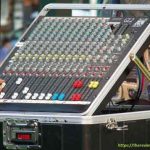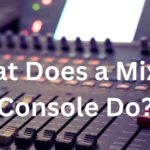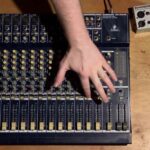A mixing console is a device that allows various audio signals to be combined and manipulated. The inputs and outputs of the mixer are typically connected to audio devices such as microphones, instruments, and loudspeakers. The mixer also has controls that allow the user to adjust the level, delay, and other characteristics of each input signal. Every mixing console user should know how does a mixing console work?
In this article, we will know in detail how the mixing console works.
A mixing console is a vital piece of equipment for any audio engineer. But how does it work? At its most basic, a mixing console takes input from multiple sources and allows the engineer to control the levels of each individual source.
This way, the engineer can ensure that each element in the mix is balanced and sounds good on its own. However, a mixing console also offers much more than just level control. For example, many consoles have EQ controls built-in, which allow the engineer to shape the sound of each individual track.
This way, they can make sure that all the tracks in the mix sound great together. There are also a variety of other features that a mixing console may offer, such as panning controls and effects send/returns. But at its core, a mixing console is simply a tool that allows an engineer to take multiple input sources and create a balanced mix.
Remember, to get better service from your mixing console must get the best mixing console for recording studio. Otherwise, you will be disappointed in your mixing console.
Table of Contents
What is Audio Mixer Used for?
An audio mixer is used to take the sound from multiple sources and mix them together. This can be done for live events or for recordings. The audio mixer will take the input from each source and adjust the volume, EQ, and other settings as needed.
Then, it will send the mixed signal to a PA system or recorder. There are many different types of audio mixers available on the market. Some are very simple with only a few inputs and basic controls.
Others are much more complex and have a wide range of features. Choosing the right mixer depends on your needs. If you only need to mix a few signals, then a simple mixer will suffice.
However, if you need more control over your mix, then a more complex mixer may be necessary. Audio mixers come in both analog and digital varieties. Analog mixers are typically cheaper but can introduce noise into your signal path.
Digital mixers tend to be more expensive but provide cleaner sound quality since they convert the incoming signals into digital form before processing them.
What are the Five Major Functions of the Audio Console?
The audio console is the central nervous system of the sound reinforcement system. Its primary function is to take all of the input signals from the various microphones and other sources, process them as needed, and then route them to the appropriate output devices. There are typically five major sections on an audio console:
1. Input section:
This is where all of the input signals are connected. The input section also includes controls for setting the level of each signal, EQ (equalization) controls, and aux send/returns.
2. Mix bus:
The mix bus takes all of the processed input signals and combines them into a single signal.
The mix bus can be further processed by additional EQ or effects before being routed to the main output section.
3. Output section:
The output section connects to the power amplifiers and speakers. The level of each output signal can be controlled independently.
Additionally, there are usually dedicated controls for setting up a monitor mix, which sends a different mix of signals to onstage monitors so that performers can hear themselves better while they’re performing.
4. Master section:
The master section contains overall control functions for the entire console, such as master faders for controlling the overall levels of all channels combined, master EQ controls, etc.
5. Patchbay:
A patchbay allows you to connect external devices directly into your console without having to use any physical cables .
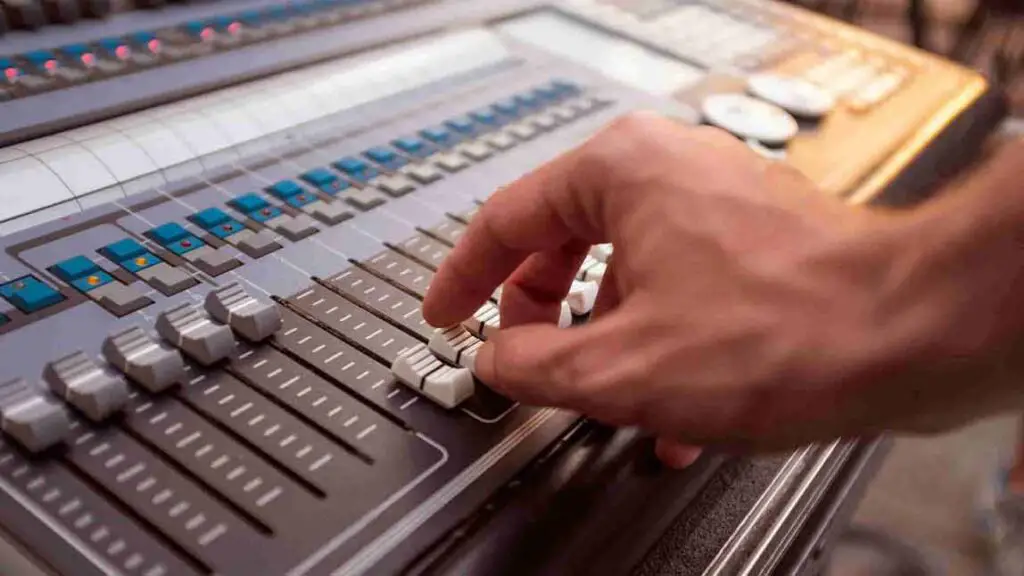
What Does a Mixer Do?
A mixer is a kitchen appliance that is used to mix, chop and grind food. It can also be used to make sauces, purees and soups. A mixer typically has a number of different attachments that can be used for different tasks such as chopping, grinding or pureeing. Read More to know more deeply.
What Does a Sound Mixer Do in Film?
A sound mixer is a key member of a film crew, responsible for recording and mixing the audio on set. They capture dialog, Foley effects, and ambiance to create a finished track that will be used in the final edit of the film. Sound mixers work closely with the director and cinematographer to ensure that the audio meets the vision for the project.
They use a variety of microphones and other equipment to record dialogue, music, and sound effects. In post-production, they mix all of these elements together to create a balanced and cohesive track. The role of a sound mixer is essential in creating a quality film experience.
Without their skill and expertise, films would lack vital auditory components that immerses viewers into the story.
Audio Mixer Tutorial Pdf
An audio mixer is a powerful tool that can take your audio production to the next level. In this tutorial, we’ll show you how to use an audio mixer to get the most out of your recordings. We’ll cover everything from setting up your mixer to using its various features to create professional-sounding results.
By the end of this tutorial, you’ll have a solid understanding of how an audio mixer can help you improve your productions.
How Do You Use a Mixing Console?
A mixing console is a vital piece of equipment for any audio engineer. It allows the engineer to control the levels of each individual track, as well as add effects and process the signal in various ways. In this article, we’ll take a look at how to use a mixing console and some of its features.
The first thing you need to do when using a mixing console is to make sure all your tracks are properly routed into the mixer. Each track will typically have its own channel on the mixer, so you’ll want to make sure each one is going into the right place. Once everything is properly set up, you can begin adjusting levels.
If you’re just starting out, it’s generally best to keep things fairly simple. Start by setting all your faders (the horizontal sliders on each channel) at unity gain, which means they’re sending no signal boost or cut. From there, you can start raising or lowering individual tracks to taste.
As you get more experience, you’ll develop a better ear for what sounds good and what doesn’t, but in general it’s best to err on the side of caution when first starting out. Once you’ve got your basic levels set where you want them, it’s time to start thinking about effects. A typical mixing setup will have a variety of different effect units connected to it, such as reverb and delay units.
These can be used sparingly to add some extra depth and dimensionality to your soundscape; too much of either one can quickly make things sound muddy and cluttered though, so again it’s important to use them judiciously. There are literally endless possibilities when it comes to using a mixing console; these are just some basics tips to get you started. Experiment and have fun with it – that’s really the best way to learn! Read More Details…
What are the 3 Main Functions of a Mixer Console?
A mixing console, or simply mixer, is an electronic device for combining, routing, and changing the level, timbre and/or dynamics of audio signals. A typical DJ mixer may have anywhere from two to eight channels, each with its own volume fader and other controls.
The three main functions of a mixer console are as follows:
1) To route audio signals to the appropriate destination;
2) To adjust the levels of those signals;
3) To add effects to those signals (if desired).
Each of these functions is accomplished using a variety of knobs, buttons and sliders on the face of the mixer. Let’s take a more detailed look at each one:
Routing Audio Signals:
The first thing you need to do when setting up your mixer is determine which devices will be sending audio signals into it, and where those signals need to go.
This is done using the input ports on the back of the mixer. Each input port is typically labeled with the type of device it’s meant for (e.g., “mic,” “line,” etc.), as well as a number that corresponds to a channel on the front of the mixer. For example, if you’re connecting a microphone to input 1, that signal will be routed to channel 1 on the front of the mixer.
Once all of your input devices are connected, you’ll need to use the routing switches on each channel to determine where those signals will go next. These switches will be labeled with various output options (e.g., “main,” “monitor,” etc.), allowing you to send each signal where it needs to go.
Adjusting Signal Levels:
The next step is adjusting the levels of each signal coming into your mixer.
This is done using either potentiometers or faders (sliding pots), depending on which type of mixer you have. As you increase or decrease these levels, you’ll also want to keep an eye on any peak meters that are present – these will give you a visual indication of how close your signal is to clipping (distortion caused by too much level). Too much clipping can cause damage to your speakers or other equipment downstream from your mixer, so it’s important not watch these levels carefully!
In general, you’ll want most peak meters to stay below 0 dB for best results.
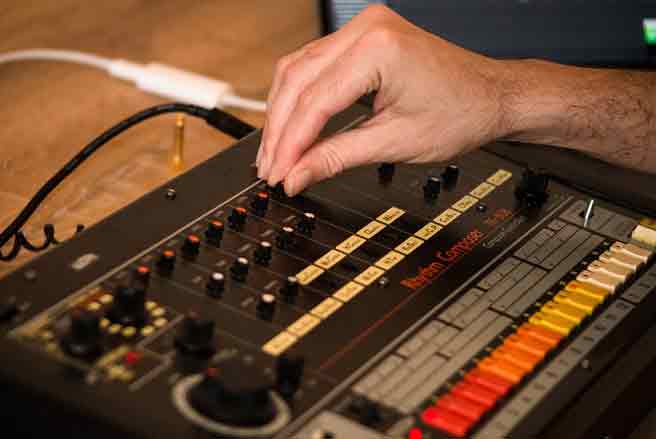
How Does a Digital Mixing Console Work?
A digital mixing console is a type of audio mixer that uses digital signal processing to alter and enhance the sound of an audio signal. The digital mixing console takes an input signal, processes it using a variety of algorithms, and then outputs the processed signal. The digital mixing console has a number of advantages over its analog counterpart.
First, because the digital mixing console processes the signal in the digital domain, there is no loss of quality due to degradation from analog-to-digital conversion.
Second, the use of DSP algorithms allows for more precise control over the sound of the output signal.
Finally, the use of digital technology makes it possible to store settings and recall them at a later time.
Digital mixing consoles are typically controlled via a touchscreen interface or a traditional fader-based interface. The touchscreen interface provides direct access to all of the controls and settings on the mixer, while the fader-based interface gives users a more tactile way to control the mixer. Both types of interfaces have their own strengths and weaknesses, so it ultimately comes down to personal preference as to which one is used.
Also Read: What is Matrix on Mixing Console?
How Does a Mixer Works?
A mixer is a device that combines two or more audio signals and routes them to an output. Mixers are used in a wide variety of applications, including live sound reinforcement, recording studios, broadcast television, and film post-production. Live sound reinforcement mixers are typically used to manage multiple microphones and other input sources for a live performance.
For example, a typical rock band may use several microphones on the drums, guitar amps, and vocalists. The audio signals from these various sources are then combined by the mixer and sent to the main PA system for amplification. In recording studios and broadcast television facilities, mixers are used to manage multiple audio signals from various sources such as microphones, musical instruments, and tape machines.
These signals are combined and routed to an audio recorder or playback system. Film post-production mixers combine dialogue (recorded in the studio), music (recorded in the studio or added during post-production), and sound effects (created during post-production). The resulting mix is then recorded onto one or more master tapes or digital files for distribution.
How Audio Mixers Work – What is a Mixer & What Does it Do? | Live Sound Lesson
Also Read: What You Need to Know About Live Mixing Consoles?
Conclusion
A mixing console is a vital piece of equipment in any music studio. It allows the engineer to mix different audio signals together and route them to various devices. But how does a mixing console work?
Let’s take a closer look. The mixing console is the heart of the recording studio, where all of the audio signals are routed and mixed together. The engineer uses the mixing console to control the level of each signal, as well as other parameters such as EQ and panning.
Each input on the mixing console has its own channel, which can be adjusted independently. The engineer can also route signals to different outputs on the mixing console, such as speakers or headphones. This allows them to create a mix that sounds good on multiple playback systems.
So, that’s how a mixing console works! By routing and adjusting audio signals, the engineer can create a professional-sounding mix that will please even the most demanding listener.

Williams Kane is a blogger and writer. He’s passionate about writing and connecting with the community, especially when it comes to sharing his ideas through writing.
I am a versatile author with a passion for exploring a wide range of topics on our multi-niche website. With a background in research and a love for writing, I bring a unique blend of expertise to our platform.
My journey began in the world of science, where I earned a degree in biology and developed a deep fascination for the natural world. This background enables me to delve into topics related to ecology, environmental conservation, and the wonders of the animal kingdom.
However, my curiosity knows no bounds, and I have ventured into various other niches as well. From technology trends and digital innovations to health and wellness tips, I strive to provide well-researched and engaging content that informs and entertains our diverse audience.
Furthermore, my dedication to staying current with the latest developments in each niche ensures that our readers receive up-to-date and reliable information. Whether it’s deciphering complex scientific concepts or simplifying tech jargon, I take pride in making complex subjects accessible to all.
Join me on our multi-niche journey, where we explore the depths of knowledge and share insights on a multitude of topics to inspire, educate, and entertain.

